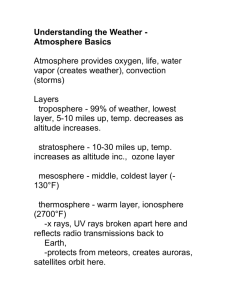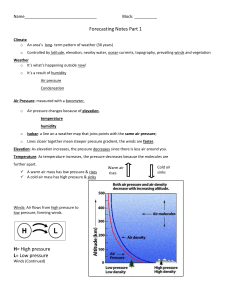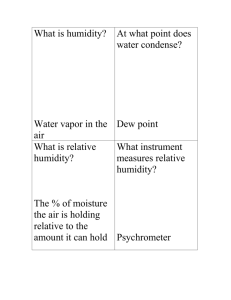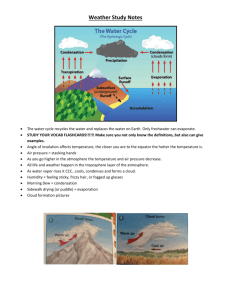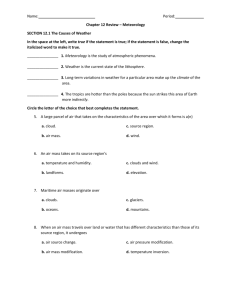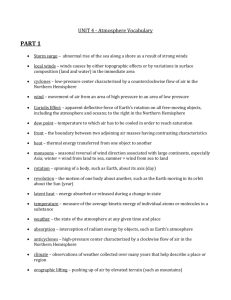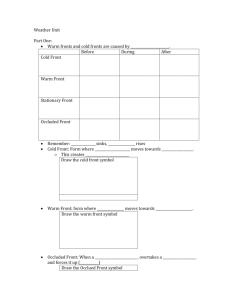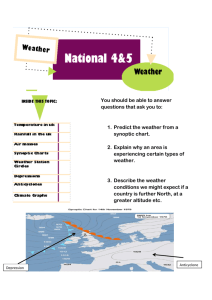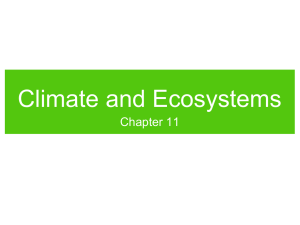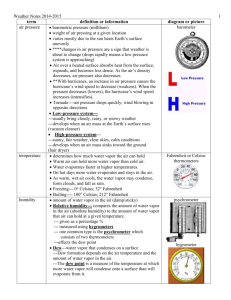Study the following figures and charts. All of the questions come
advertisement
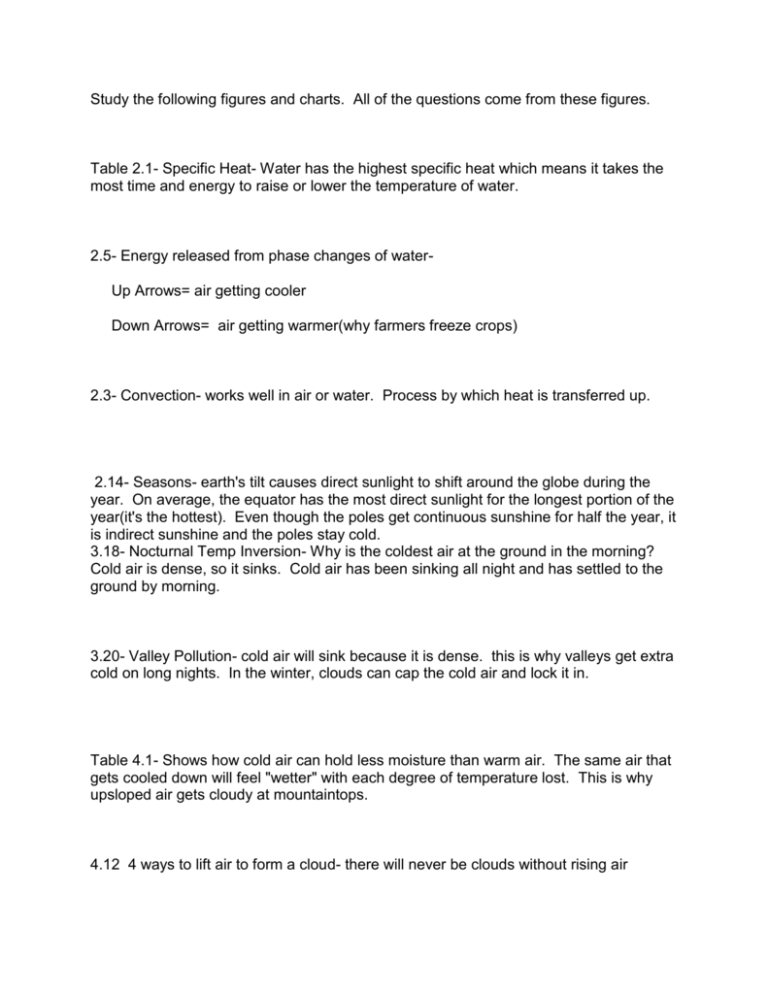
Study the following figures and charts. All of the questions come from these figures. Table 2.1- Specific Heat- Water has the highest specific heat which means it takes the most time and energy to raise or lower the temperature of water. 2.5- Energy released from phase changes of waterUp Arrows= air getting cooler Down Arrows= air getting warmer(why farmers freeze crops) 2.3- Convection- works well in air or water. Process by which heat is transferred up. 2.14- Seasons- earth's tilt causes direct sunlight to shift around the globe during the year. On average, the equator has the most direct sunlight for the longest portion of the year(it's the hottest). Even though the poles get continuous sunshine for half the year, it is indirect sunshine and the poles stay cold. 3.18- Nocturnal Temp Inversion- Why is the coldest air at the ground in the morning? Cold air is dense, so it sinks. Cold air has been sinking all night and has settled to the ground by morning. 3.20- Valley Pollution- cold air will sink because it is dense. this is why valleys get extra cold on long nights. In the winter, clouds can cap the cold air and lock it in. Table 4.1- Shows how cold air can hold less moisture than warm air. The same air that gets cooled down will feel "wetter" with each degree of temperature lost. This is why upsloped air gets cloudy at mountaintops. 4.12 4 ways to lift air to form a cloud- there will never be clouds without rising air 1- Convection from the heating of the day from the sun 2- Orographic Lifting(upsloping)- as air goes uphill, it encounters less pressure. therefore, it expands and cools and condenses. 3- Fronts- cold air goes under warm air, which is forced up and condenses 4- Convergence of air masses- air acts like a wall to other air mass and both are forced up 4.34- Precipitation Types 1- Rain falls from a cloud as any type of precipitation, falls through warm air and falls as liquid 2- Freezing Rain falls from a cloud as, typically, snow and then melts. When freezing rain hits subfreezing ground, it freezed on contact. 3- Sleet- usually falls as snow. Sleet is warmed to above freezing mid-descent and is briefly liquid rain. Sleet is re-frozen before reaching the ground and falls as a solid ice pellet. 4- Snow- falls from subfreezing clouds through subfreezing air and onto subfreezing ground 4.39- As air is upsloped, it will expand, cool and condense. As air gets to the downhill side, it will compress, warm and dry. This is why the downwind side of mountains is drier. The downwind side of mountains is what is called the "rain shadow". 6.4- Air moves counterclockwise and towards low pressure. Air moves clockwise and away from high pressure. The force that moves air relative to pressure zones is called the Pressure Gradient Force(PGF). 6.9- Coriolis- Spinning of the earth causes objects to be bent right in the Northern hemisphere and left in the Southern hemisphere. 6.24- Areas of High pressure have sinking, compressing, warming and drying air. Winds diverge from Highs. Areas of Low pressure have rising, expanding, cooling and condensing air. Winds converge around Lows. 7.6- Hadley Cells- caused by unequal heating of earth, there are bands of winds that circle the globe. Air rises at the equator and sinks at 30N. Air sinks at 90N because of the weak sun. The flow of air around the globe is then affected by coriolis. These factors cause the trade winds to flow from East to West around the equator. Also, Westerlies, or the Jet Stream, flow from West to East between 30-60N. Finally, Polar Easterlies flow from East to West from 60N-90N. 7.20- ITCZ shifts from about 25N-25S throughout the course of the year based on which hemisphere is having their most direct sunlight, and therefore summer. 8.3- Ocean currents carry lots of energy around the globe. Warm ocean currents will only be shallow because they will be as deep as the sun can penetrate. 8.8- The Atlantic Ocean is giant whirlpool with warm water flowing up the E coast of America, crossing the Atlantic as the Gulf Stream, cooling as it hits Europe where the water will sink and flow down the W side of Europe. When coriolis bends the water back E across the Atlantic, it will be warmed by equatorial sun and come back as the Gulf Stream. 8.12- El Nino- warming of the E Pacific because of a slackening of the trade winds. This causes flooding in S America, drought in Asia and a poor ski season in America. Why the trade winds slacken is unknown. 8.27- Hurricanes are giant counterclockwise whirls. The side of a hurricane that has onshore winds + storm direction has the worst of the winds and storm surge. 9.15- Another cold front picture. When cold air undercuts warm air, it forces the warm air up. This, in turn, starts expansion, cooling, condensation, precipitation. 11.9- Multi-cell t-storms have cells at all 3 stages of development. Cumulus stage is the UPDRAFT stage. Mature is the balance of UP and DOWNDRAFTS. Dissipating stage is the DOWNDRAFT stage. 14.25- Global changes in orbit as they change climate(not weather). The earth's orbit can be flatter or rounder. Flatter = more extreme and rounder = milder. Earth's tilt can be more or less than 23.5degrees. More = more extreme climate, less = more mild climate. Earth's axis can wobble(precession) which causes us to get slightly more or less sun. 15.15- The much debated "hockey stick graph". This is a graph of global temperature change. The rise in the graphs correspond to an increase in carbon dioxide in the atmosphere, which is due, in part, to human activities. The presence of sulfur aerosols lessens the effect of the GHG's because the sulfur aerosols block sunlight.

